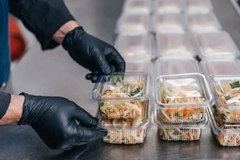Ready meal pack transition: Experts gear up for latest R&D displays at Interpack 2023

03 May 2023 --- Ready meals have seen an increase amid the COVID-19 pandemic and continue to trend upward even as the pandemic comes to an end. Consumers favor flavorful quick meals that require minimal preparation and are readily available, according to food packaging experts gearing up to present their latest solutions at Interpack in Düsseldorf, Germany, this week.
Irma Randles, marketing manager at ProAmpac, says that the company does not see the ready meal market taking a turn soon “as consumers resume on-the-go lifestyles and return to offices where these convenient, quick meal options save time and resources.”
In response to this continued positive trend, ready meal packaging has seen a shift in R&D to include extended shelf life options, focusing on convenience and enhanced environmental sustainability.
“During the pandemic, R&D slipped down the industry’s priority list in favor of throughput. Now, it’s firmly back on the menu. Much of our focus is on helping customers with their plastic substitution goals. From a ready meal perspective, we’re focused on developing new and improved solutions for applications requiring an oxygen barrier and those that don’t,” explains Jeff Voyzey, director of business and product development at Graphic Packaging International (GPI).
 GPI’s PaperSeal Cook packaging is a dual-ovenable variant designed for applications such as fresh ready meals.Fiber-based and rapid action
GPI’s PaperSeal Cook packaging is a dual-ovenable variant designed for applications such as fresh ready meals.Fiber-based and rapid action
Meanwhile, ProAmpac offers a fiber-based packaging line of products, including trays for ready meals designed with the optimum balance between product visibility and branding opportunities, sustainability and ease of use while retaining ultimate product freshness.
“Our fiber-based trays feature a fully laminated film lining and a large window that offers moisture protection, product visibility and are available in various shelf life options to ensure freshness. Due to our easy peel technology, consumers can easily separate the film lining from the carton board and recycle the carton board in recycling streams,” explains Randles.
GPI says the company is “thrilled” to be attending this year’s Interpack, “one of the highlights of our European trade fair calendar.” “We’ll be highlighting PaperSeal Cook, our award-winning, fiber-based, dual-ovenable MAP tray for chilled ready meals and visitors to our booth will be able to see the PaperSeal tray being sealed with our range of lidding film.”
“We’ll also be showing our range of pressed board trays that offer an economical solution for frozen meals,” says Voyzey.
ProAmpac will have a full range of hot and cold fresh food-to-go product RAP packaging product line on display. “This is the first time ProAmpac is demonstrating our RAP Packaging solution at Interpack. We will also have our award-winning RecycAll package on display,” says Randles.
Food preservation challenges
Ready meals require various storage and use conditions, including cold chain and microwave conditions. Randles highlights that the challenge for food preservation is understanding the storage and use of the ready meal to ensure the proper packaging materials are used.
“Whether the product is being packaged for more immediate consumption or purchased to store and be heated and eaten later plays a significant role in ensuring proper shelf life techniques are applied,” she explains.
“ProAmpac can offer retailers fiber-based packaging options from day fresh to extended shelf life. Our extended shelf life includes modified atmosphere (MAP) options that can extend product freshness to several days or several weeks. The added benefit of MAP packaging is a reduction in food waste to landfill as the product in the packing stays fresher for longer.”
 ProAmpac’s Recycle Ready Retort. In addition to its fiber-based packaging, ProAmpac offers a variety of other flexible packaging for ready meals that include a variety of fitments, closures, storage and use conditions and shelf differentiation techniques.
ProAmpac’s Recycle Ready Retort. In addition to its fiber-based packaging, ProAmpac offers a variety of other flexible packaging for ready meals that include a variety of fitments, closures, storage and use conditions and shelf differentiation techniques.
“We offer several re-close options to aid portion control or fitments for directional pouring with closure. Our spouted pouches are among the most popular designs for ready meals like soups. Their shape is reminiscent of traditional boxed options but gives an easier pouring and storing experience.”
“While reducing the amount of plastic is important to customers, this can never be at the cost of increased food waste. The UN estimates around a third of all food worldwide is wasted, which comes with a significant GHG impact,” warns Voyzey.
Jan-Mark Wilke, business development manager for Fresh Food for Consumer Flexibles at Mondi, stresses that if not packaged properly, delicate food products can be compromised before making it to the dinner table.
“Discarding these compromised or damaged products lead to another challenge: food waste. Thirty three percent or 1.3 billion metric tons of the world’s food is lost or wasted annually, accounting for 7% of GHG emissions.”
“The right packaging can play a vital role in protecting these delicate foods while providing convenience and portion control for the consumer. It prevents exposure to gasses and moisture and protects the product packed from damage. It can extend the shelf life considerably. To achieve all these functionalities, a tailored barrier protection is needed: barriers against water vapor, grease, oxygen, mineral oil or damage caused by external influences,” says Wilke.
Plastic vs. paper debate
Voyzey continues by saying that plastic can still play an important role where an oxygen, grease or moisture barrier is required, for example, for chilled ready meals. “Using just the right amount of plastic in a hybrid tray solution, where a paperboard tray is combined with a liner, can significantly reduce plastic while maintaining the shelf life and performance of a traditional tray.”
“Our PaperSeal range is an ideal example of how this can be achieved. PaperSeal is comprised of a paperboard tray with a liner. The one-piece rigid flange provides excellent hermetic sealing for modified atmosphere and vacuum skin applications, delivering a shelf life equivalent to traditional plastic trays,” explains Voyzey.
“That makes it ideal for fresh and processed meat and fish, fresh salads, prepared fruit, fresh pastas and dips. PaperSeal reduces plastic by up to 90% versus traditional trays, and once the liner is removed (in those countries where that is a requirement), the fiber-based tray can be recycled in normal paper waste streams,” says Voyzey.
“The PaperSeal range also includes PaperSeal Cook, a dual-ovenable variant specifically designed for applications such as fresh ready meals. This pack offers the protection and preservation benefits of a traditional plastic tray while reducing overall plastic use by around 80%,” explains GPI’s director for business and product development.
Wilke explains that Mondi uses “paper where possible and plastic when useful.”
“Paper has certain sustainability benefits, as being made of renewable resources, recyclable and with the highest recycling rates compared to other material,” he says.
 small.png) Mondi’s pouches for ready meals.More e-commerce, less hygiene concerns
Mondi’s pouches for ready meals.More e-commerce, less hygiene concerns
While the concern for hygiene in ready-meal packaging is not as strong as during the pandemic, the concern for freshness remains high. Equally as important is the need for convenience in the form of quick grab-and-go and through e-commerce channels, explains ProAmpac’s marketing manager Randles.
“Sustainability has also regained ground as a top focus for most brands when it comes to packaging innovations and for end-use consumers.”
Regarding convenience, heat-and-eat meals or meal supplements like soups, pastas, potatoes, vegetables, or other quick options require packaging as convenient as the meal. Moving these products from cans or film trays inside boxes to microwavable pouches allows consumers to skip the can-opener, bowl and dishwashing to eat directly from the pouch, therefore, reducing preparation, clean-up and use of secondary opening devices.
Additionally, microwavable pouches can be manipulated easily to get all the product out of the package to eliminate food waste, highlights Randles.
“The past two years have accelerated an already growing e-commerce market. Home delivery for food is growing among traditional grocery retailers along with the expansion of virtual food stores,” stresses Randles.
“Pre-packaged ready meals that are quick and easily accessible, as well as packaging that can withstand the rigors of shipping and handling, are key. Flexible packaging is a great solution for brands as pouches provide the product protection needed to meet shelf life requirements but are also lighter weight and less breakable than rigid containers,” she continues.
Reduced plastic usage not at quality expense
Randles observes that brands are looking to make their packaging more sustainable. The first step is always to reduce the amount of packaging currently used for a product. Packaging reduction often has the highest impact on a product’s carbon footprint because of weight and space savings.
“Moving from rigid packaging to flexible can significantly impact the sustainability of a brand’s packaging. Further, materials with enhanced sustainability characteristics enable recyclability, including post-consumer recycled content and bio-based resin,” she explains.
“Today, consumers desire less overall plastic in their packaging. Studies show this is universal across sectors, and ready meal packaging is no exception. Consumers are increasingly aware of the consequences of unnecessary plastic waste and want to see manufacturers, brands and retailers take firmer action,” says Voyzey.
However, he asserts that consumers don’t want reduced usage of plastic packaging to come at the cost of hygiene, shelf life or quality.
“For certain applications, plastic is needed to achieve the required barrier level to protect for example, valuable food products and for these, we need to design recyclable solutions that contribute to a circular economy,” concludes Wilke.
By Natalie Schwertheim











